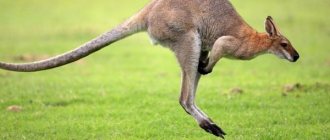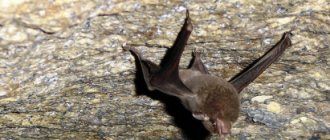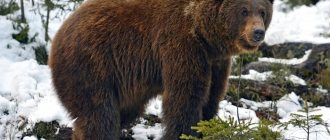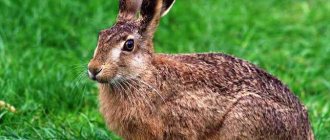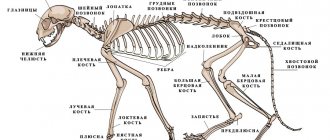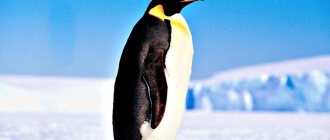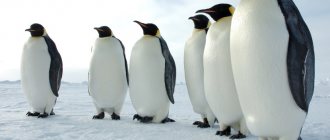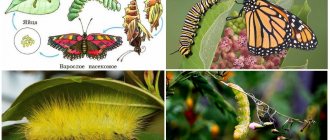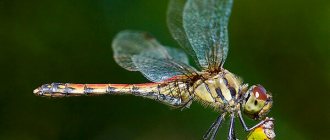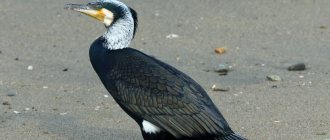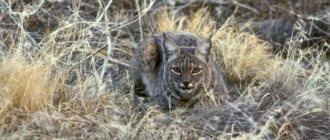Kangaroos are marsupials; there are about sixty different species. This is one of the most amazing mammals living on the planet.
There are terrestrial species - some live on plains covered with bushes and grass, others in rocky areas, and some species can climb trees. They are extremely shy and cautious, as a rule, they stay in groups.
Interesting Facts
Cubs are born very quickly - only 30-40 days, kangaroos are born very small - the length of a newborn calf is no more than 3 cm.
These animals have striking differences from representatives of other fauna of the globe. For example, they can move exclusively forward - moving backward is hampered by a huge tail and the unusual structure of the hind legs.
Individuals of one species reach a weight of 90 kg, while representatives of the other species do not exceed a weight of 1 kg. Kangaroos produce two types of milk for feeding their young - there are always two of them in the animal's pouch, one of which is almost grown, and the second is a newborn. The photo shows two babies of different sizes peeking out of a kangaroo's pouch.Kangaroos are very smart animals - residents of the places where these mammals live have more than once observed how, escaping from pursuit, a kangaroo lures an enemy into a pond and then tries to drown it.
Dingoes, wild dogs that hunt kangaroos, have suffered this fate more than once.
Images of a kangaroo and an emu adorn the Australian state coat of arms.
Caring for offspring
Kangaroo cubs are born premature (weighing no more than 1 g and 2 cm long) and grow and develop in the mother’s pouch for quite a long time. Once born, the baby immediately crawls into its mother’s pouch and attaches itself to one of the four nipples. Each nipple produces its own type of milk, which depends on the age of the kangaroo. Moreover, if there are cubs of different ages, the mother can have two types of milk at the same time. The baby finally leaves the pouch only after reaching 8 months of age. Very often, at a moment of danger, a kangaroo takes the baby out of the pouch, hides it in a secluded place and leads the predator away from its offspring. Having escaped from the chase, the mother returns to the kangaroo and puts him back in the bag.
Where does the kangaroo live?
Their habitats, as a rule, are the arid territories of the planet - these animals inhabit Australia, New Guinea, are found on the Bismarck Islands, Tasmania, and are found in England and Germany.
Kangaroos have adapted to live even in cold climates - they also live in countries where snowdrifts in winter sometimes reach their waists.
Lifestyle and habitat
The red kangaroo is nocturnal: during the day it sleeps in grass burrows (nests), and at nightfall it actively searches for food. Red kangaroos live in savannas and pastures rich in food in Australia.
Marsupials live in small flocks, which include a male and several females, as well as their cubs. When there is a lot of food, kangaroos can gather in large flocks, the number of which exceeds 1000 individuals.
Males defend their pack from other males, as a result of which fierce fights often occur between them. Red kangaroos constantly change their location as food runs out in their habitat.
Description of the body structure of a kangaroo
This animal has unusually long and strong hind legs, they allow it to long jump at a distance of up to 12 m and reach a speed of about 60 km/h, but the kangaroo will not be able to move at a breakneck pace for more than 10 minutes.
The kangaroo balances with the help of a huge, powerful tail - thanks to it, the animal can maintain balance in almost any situation.
The shape of the kangaroo's head is a little similar to the head of a deer; compared to the body, it seems very small.
The animal's shoulders are disproportionately narrow, the forelimbs are short, they are not covered with fur, and on each paw there are five very mobile fingers, pumping with claws - they are necessary to hold food and comb out fur.The lower part of the body is much more developed than the upper. Thanks to their powerful tail, the animals sit - when they rely on the tail, their lower limbs rest.
The lower paws have four toes, while the second and third are connected by a membrane, and the fourth grows a well-developed razor-sharp claw.
Kangaroo fur is thick and short, it saves you from the heat in the summer and warms you up in the cold season. The color is not very bright - from gray to ash-brown; some species have red or brown hair.
- Detailed description with photos of all animals included in the Red Book of Russia
Zebra - habitats, appearance, diet and behavior, life cycle + 94 photos
Leopard - habitats, life cycle, rutting season and lifespan + 118 photos
The growth of a kangaroo depends on the species - the length of the body can be 1.5 m, and there are individuals only the size of a rat - these are representatives of the rat family - the so-called kangaroo rats.
The animal moves only on its hind legs and exclusively by jumping - it cannot move its legs one after another. And in order to eat food located not on a tree, but on the ground, it brings the body into a position almost parallel to the ground.
Only forward!
Kangaroos are the only large animals that move by jumping. Moreover, when moving on the ground, they use both hind legs simultaneously, and when swimming, they use them in turn. The animal cannot move backwards at all. This is probably why the kangaroo is depicted on the state emblem under the motto “Australia always moves forward!”
Kangaroos cannot be called notorious fighters, but when it comes to a serious fight, the fight begins with threatening poses and ends with powerful blows from the hind legs to the stomach. At the same time, they skillfully use their powerful tail - it acts as an additional support when taking a vertical stance. The long tail and powerful hind legs allow the kangaroo to jump over two-three-meter fences, and in case of danger, reach speeds of 45 to 55 km/h, sometimes up to 65 km/h.
What do kangaroos eat?
These are ruminant animals; they chew their food twice; after swallowing, they regurgitate part of the portion and chew it again. The kangaroo's stomach produces special bacteria that help digest tough plants.
Tree-dwelling species eat fruits and foliage, while the rat subspecies feeds on roots and insects.
Kangaroos can go without drinking for a long time, so they consume little water.
Kangaroo as a symbol of Australia
The kangaroo and emu are recognized symbols of Australia, appearing on the Australian coat of arms and arms, as well as on the 50 cent coin. Kangaroos (marsupials) and emus (a large bird that cannot fly) live naturally exclusively on this continent. These two exotic representatives of Australia's fauna have something in common - they very rarely move backwards. Thanks to their body shape and long, strong tail, kangaroos can move by jumping, but they have great difficulty backing up. Emus run quickly on their long limbs, but the structure of the knee joints prevents the bird from turning.
Kangaroos and emus symbolize the dignity of the Australian nation, which never retreats and moves only forward. The male emu is a caring father, he guards the clutch of eggs and raises the chicks during the first 6 months of their life. The kangaroo seemed an extraordinary and unique creature when, in 1771, Captain James Cook brought one specimen of the animal from an expedition to England on board his ship.
Joseph Banks, a naturalist who visited the continent for research purposes, commissioned the painter George Stubbs to paint a “portrait” of a kangaroo. When the scientist presented his report on the expedition, he provided it with an illustration of the animal. From that time on, the kangaroo began to be associated with the Australian continent and became an obligatory attribute of exhibitions, collections, works of art and books published in Europe about Australia. But a lot of time passed before the kangaroo became an officially recognized symbol of the country. Despite the fact that the animal was recognized as “noxious” and capable of causing damage to crops and domestic animals, in 1908 its image was included in the Australian national emblem. The kangaroo is present on the emblems and logos of various institutions and societies, sports equipment, is included in architectural decor, and is a frequently used motif in decorative and applied arts.
Kangaroos are bred at home; they are popular characters in books, TV series, cartoons, games and songs. Two red kangaroos are included in the coat of arms of Western Australia, the national passenger airliner Qantas uses an image of a galloping kangaroo as an emblem, the Government Tourism Authority uses a kangaroo in its logo for instant identification with Australia. A special symbol in the form of a golden kangaroo and a green triangle shows that the product is produced or grown in Australia. The Red Kangaroo is the logo of the Australian Shipping Service, part of the official emblem of the Royal Australian Regiment and the Northern Territory (federal entity within Australia) and its police force. The word "kangaroo" is included in many geographical names in Australia - Kangaroo Island, Kangaroo Suburb - Bendigo Suburb (Victoria), Kangaroo Land (a city in Victoria), Kangaroo River, Kangaroo Valley, Kangaroo Reservoir, etc.
Reproduction and lifespan
Kangaroos do not have a seasonal breeding season; they mate throughout the year. Males are characterized by mating battles, the winner impregnates the female, and after 30-40 days the cubs are born - always no more than two, the body length of a newborn kangaroo is 2-3 cm.
Female kangaroos have an amazing ability - while the eldest cub is fed with milk, the female can delay the birth of the next one.
In fact, the baby of this animal is an underdeveloped embryo, but immediately after birth it is able to independently move into the pouch, where it will grow and feed for two months.
The pouch reliably covers the baby - by contracting the muscles, the female can close and open the marsupial compartment on the abdomen. In the wild, the average lifespan of a kangaroo, depending on the species, is 10-15 years, and in captivity, some individuals lived up to 25-30.
Despite the fact that the brain of these mammals is poorly developed, like any other living creature on the planet, kangaroos are characterized by a certain ingenuity and a well-developed instinct of self-preservation.
Unfortunately, these interesting and unusual animals have not escaped their participation in the food chain of the globe. Their meat is edible; Australian Aborigines have been eating it for many centuries.
And some Australian scientists even believe that kangaroo meat is less harmful than lamb and beef. Since 1994, its export has been established to Europe.
Lifestyle
Marsupials prefer to be nocturnal, appearing in the pastures at dusk. During the day they rest in burrows, nests made of grass or in the shade of trees.
If one of the animals notices any danger (for example, a dingo dog wants to taste kangaroo meat), the message about this is immediately transmitted to the rest of the pack by striking the ground with its hind legs. They often use sounds to convey information - grunting, sneezing, clicking, hissing.
If the area has favorable living conditions (abundance of food, absence of danger), marsupials may well form a large community of one hundred individuals. But, usually they live in small flocks, which consist of a male, several females and kangaroo chicks growing in the pouch. At the same time, the male very jealously protects the flock from other males, and if they try to join, fierce fights occur.
These animals are characterized by attachment to a certain territory, and they prefer not to leave it without special reasons (the exception is the huge red kangaroo animals, which are able to travel several tens of kilometers in search of the best feeding areas).
Despite the fact that marsupials are not particularly smart, they are very resourceful and know how to adapt well: if their usual food is no longer enough, they switch to other foods, eating plants that even animals that are not picky about food (for example, dry, hard food) do not eat. and even prickly grass).
Nutrition
Marsupials feed on leaves of trees and shrubs, bark, roots, shoots; some species hunt insects and worms. They either dig up food or cut it off with their teeth, and it is worth noting that they usually either do not have upper fangs at all, or they are poorly developed, but they have two large incisors on the lower jaw (another interesting fact is that they, in Unlike most mammals, teeth are constantly changing).
Marsupials are very well adapted to drought, so they can easily go for several days and even months without water (they take most of the liquid from plant foods).
If they still feel very thirsty, they dig a well a meter deep with their paws and get to the precious moisture (at the same time helping other animals suffering from lack of water). During this time, they try not to waste energy: during the dry months, they move less and spend more time in the shade.
Reproduction
The ability to reproduce begins as early as one and a half to two years (they live from 9 to 18 years; cases have been recorded where individual specimens lived to be thirty). At the same time, males fight so fiercely for the female that the collision often ends in severe injuries.
A female usually gives birth to only one baby kangaroo, less often twins. Before the baby is born, the mother carefully licks the pouch (a fold of skin on the abdomen intended for the development of a baby kangaroo) and makes it clean.
Pregnancy lasts from one to one and a half months, so the baby kangaroo is born blind, without hair, its weight does not exceed one gram, and its length is no more than three centimeters in large species. As soon as it is born, it immediately clings to its mother’s fur and crawls into the pouch, in which it spends about eleven months.
In the pouch, he immediately grabs one of the four nipples and does not tear himself away from it for two and a half months (at the initial stage, he is not yet able to suck milk; the liquid is released on its own under the influence of a special muscle). By this time, the baby is developing, growing up, gaining sight, growing fur and begins to leave the shelter for a short time, while he is very alert and jumps back at the slightest sound.
After the baby kangaroo begins to leave the pouch for a long time (between 6 and 11 months of age), the mother gives birth to the next baby. Interestingly, the female is able to delay the birth of a baby kangaroo until the previous baby leaves the pouch (it is either too small, or there are unfavorable weather conditions, for example, drought). And then, in case of danger, he will remain in shelter for several more months.
Interesting facts about raccoons119194.714
And here an interesting picture is observed when the female begins to produce two types of milk: from one nipple the already grown cub receives fattier milk, from the other the newborn feeds on milk with less fat content.
Photo of kangaroo
Relationships with people
In nature, the large kangaroo has few enemies: kangaroo meat only attracts foxes, dingoes and birds of prey (and even then, marsupials are quite capable of protecting themselves with the help of their hind legs). But relations with humans are tense: pastoralists, not without reason, accuse them of damaging crops in pastures, and therefore shoot them or scatter poisonous baits.
In addition, most species (only nine are protected by law) are allowed to be hunted to regulate numbers: kangaroo meat, which contains a huge amount of protein and only 2% fat. It is worth noting that kangaroo meat has long been one of the main sources of food for the natives. Clothes, shoes and other products are made from animal skins. Animals are often hunted for sport, so many species are found only in uninhabited areas
